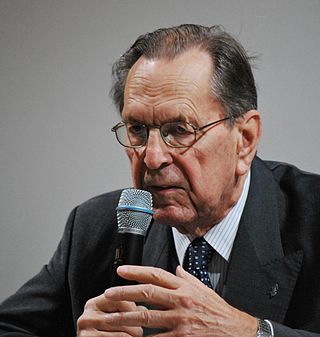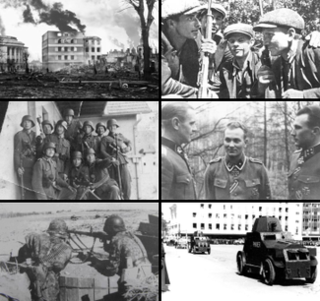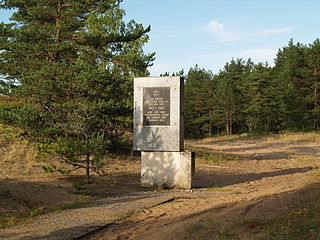
The war-responsibility trials in Finland were trials of the Finnish wartime leaders held responsible for "definitely influencing Finland in getting into a war with the Soviet Union and United Kingdom in 1941 or preventing peace" during the Continuation War, the Finnish term for their participation in the Second World War from 1941–1944. Unlike other World War II war-responsibility trials, the Finnish trials were not international. The trials were conducted from November 1945 through February 1946 by a special court consisting of the presidents of the Supreme Court of Finland, the Supreme Administrative Court of Finland, a professor from the University of Helsinki and twelve MPs appointed by the Parliament of Finland. The accused were convicted and were imprisoned until they were eventually paroled and then pardoned.

Max Jakobson was a Finnish diplomat and journalist of Finnish-Jewish descent. Jakobson was an instrumental figure in shaping Finland's policy of neutrality during the Cold War.

Klooga concentration camp was a Nazi forced labor subcamp of the Vaivara concentration camp complex established in September 1943 in Harju County, during World War II, in German-occupied Estonia near the village of Klooga. The Vaivara camp complex was commanded by German officers Hans Aumeier, Otto Brennais and Franz von Bodmann and consisted of 20 field camps, some of which existed only for short periods.
The Estonian resistance movement was an underground movement to resist the occupation of Estonia by Nazi Germany, 1941–1944 during World War II. Due to the unusually benign measures implemented in Estonia by the German occupation authorities, especially in contrast to the preceding harsh Soviet occupation of Estonia (1940–1941), the movement was slower to develop effective tactics on a wide scale than in other occupied countries.

During World War II, in the course of Operation Barbarossa, Nazi Germany invaded Estonia in July–December 1941, and occupied the country until 1944. Estonia had gained independence in 1918 from the then warring German and Russian Empires. However, in the wake of the August 1939 Nazi-Soviet Pact, the Stalinist Soviet Union had invaded and occupied Estonia in June 1940, and the country was formally annexed into the USSR in August 1940.

Estonia–Russia relations are the bilateral foreign relations between Estonia and Russia. Diplomatic relations between the two countries were established on 2 February 1920 after the Estonian War of Independence ended in Estonian victory with Russia recognizing Estonia's sovereignty and renounced any and all territorial claims on Estonia.
A number of war crimes trials were held during the Soviet occupation of Estonia (1944–1991). The best-known trial was brought in 1961, by the Soviet authorities against local collaborators who had participated in the Holocaust during the German occupation (1941–1944). The accused were charged with murdering up to 5,000 German and Czechoslovakian Jews and Romani people near the Kalevi-Liiva concentration camp in 1942–1943. The public trial by the Supreme Court of the Estonian SSR was held in the auditorium of the Navy Officers Club in Tallinn and attended by a mass audience. All three defendants were convicted and sentenced to death, one in absentia. The two defendants present for the trial were executed shortly after. The third defendant, Ain-Ervin Mere, was not available for execution.

The Holocaust in Estonia refers to the Nazi crimes during the 1941-1944 occupation of Estonia by Nazi Germany.
Soviet deportations from Estonia were a series of mass deportations in 1941 and 1945–1951 carried out by the Stalinist regime of the former USSR from then Soviet-occupied Estonia. The two largest waves of deportations occurred in June 1941 and March 1949 simultaneously in all three occupied Baltic countries: Estonia, Latvia, and Lithuania. The deportations targeted primarily women, children and the elderly, calling them 'anti-Soviet elements'. In addition, there were Soviet deportations from Estonia based on the victims' ethnicity and religion. Ethnic Estonians who had been residing in Soviet Russia had already been subjected to deportation since 1935.

Estonia declared neutrality at the outbreak of World War II (1939–1945), but the country was repeatedly contested, invaded and occupied, first by the Stalinist Soviet Union in 1940, then by Nazi Germany in 1941, and ultimately reinvaded and reoccupied in 1944 by the Soviet Union.

Decommunization in former communist states is the process of purging former communist high officials and eliminating communist symbols.

The Finnish Anti-Fascist Committee, also known by its Finnish abbreviation SAFKA, is a radical political organisation operating in Finland, founded in November 2008, but never registered. According to the Chairperson Johan Bäckman the committee has twenty activists and about a hundred supporters.
Estonian Auxiliary Police were Estonian collaborationist police units during World War II.

The Black Ribbon Day, officially known in the European Union as the European Day of Remembrance for Victims of Stalinism and Nazism and also referred to as the Europe-wide Day of Remembrance for the victims of all totalitarian and authoritarian regimes, is an international day of remembrance for victims of totalitarianism regimes, specifically Stalinist, communist, Nazi and fascist regimes. Formally recognised by the European Union, the Organization for Security and Co-operation in Europe and some other countries, it is observed on 23 August. It symbolises the rejection of "extremism, intolerance and oppression" according to the European Union. The purpose of the Day of Remembrance is to preserve the memory of the victims of mass deportations and exterminations, while promoting democratic values to reinforce peace and stability in Europe. It is one of the two official remembrance days or observances of the European Union, alongside Europe Day. Under the name Black Ribbon Day it is an official remembrance day of Canada. The European Union has used both names alongside each other.

Jägala concentration camp was a labour camp of the Estonian Security Police and SD during the German occupation of Estonia during World War II. The camp was established in August 1942 on a former artillery range of the Estonian Army near the village of Jägala, Estonia. It existed from August 1942 to August 1943. Aleksander Laak, an Estonian, was appointed by SS-Sturmbannführer Ain-Ervin Mere of Group B of the Estonian Security Police to command the camp with Ralf Gerrets as assistant.
Aleksander (Alexander) Laak was a lieutenant and the commander of the Jägala concentration camp during the German occupation of Estonia.
Heinrich Gutkin was a trader and the Estonian National Assembly member.
The Estonian Institute of Historical Memory is a non-governmental foundation that focuses on the investigation of war crimes and human rights violations committed by totalitarian regimes and research of totalitarian ideologies that created such regimes. The Institute aims to give the general public a comprehensive, objective and international overview of human rights violations and crimes committed by totalitarian regimes both in Estonia and abroad.
Aleksander Antson was an Estonian journalist, writer, and track and field athlete.
The Institute of Party History of the Central Committee of the Communist Party of Estonia was a research body in the Estonian SSR, managed under the Central Committee of the Communist Party of Estonia. Founded in 1947, the institute functioned as the republic-level branch of the Marx–Engels–Lenin Institute of the All-Union Communist Party (Bolsheviks). The institute was based in Tallinn.










